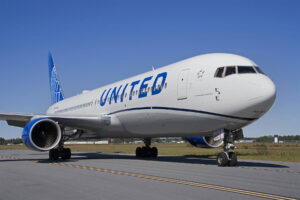Deep Vein Thrombosis (Economy Class Syndrome)
#1
Original Poster
Join Date: Jan 2002
Location: BSB
Programs: DL 2 MM
Posts: 4,914
Deep Vein Thrombosis (Economy Class Syndrome)
I fly over 200K miles domestic / year. A health risk i learned about last year is called deep vein thrombosis. It can happen by sitting in one place too long. It can happen on a plane. There is a lot of documentation that it happens all the time.
Recently a coworker in my office developed blood clots in his leg. He had been traveling on several long haul flights.
He spent 3 weeks in the hospital, 5 weeks at home on blood thinners and came back to work w/ a cane (side effect of blood thinners)
Has anyone else had problems with blood clots from long haul flying?
Recently a coworker in my office developed blood clots in his leg. He had been traveling on several long haul flights.
He spent 3 weeks in the hospital, 5 weeks at home on blood thinners and came back to work w/ a cane (side effect of blood thinners)
Has anyone else had problems with blood clots from long haul flying?
#2
FlyerTalk Evangelist
Join Date: Sep 2000
Programs: DL FO, Marriott Gold, SPG Gold
Posts: 12,003
<font face="Verdana, Arial, Helvetica, sans-serif" size="2">Originally posted by Radiocycle:
I fly over 200K miles domestic / year. A health risk i learned about last year is called deep vein thrombosis. It can happen by sitting in one place too long. It can happen on a plane. There is a lot of documentation that it happens all the time.
Recently a coworker in my office developed blood clots in his leg. He had been traveling on several long haul flights.
He spent 3 weeks in the hospital, 5 weeks at home on blood thinners and came back to work w/ a cane (side effect of blood thinners)
Has anyone else had problems with blood clots from long haul flying? </font>
I fly over 200K miles domestic / year. A health risk i learned about last year is called deep vein thrombosis. It can happen by sitting in one place too long. It can happen on a plane. There is a lot of documentation that it happens all the time.
Recently a coworker in my office developed blood clots in his leg. He had been traveling on several long haul flights.
He spent 3 weeks in the hospital, 5 weeks at home on blood thinners and came back to work w/ a cane (side effect of blood thinners)
Has anyone else had problems with blood clots from long haul flying? </font>
============================================
Personal Health
Deep Vein Thrombosis
Our customers sometimes ask us about deep vein thrombosis (DVT) and air travel. American appreciates its customers' interest in health topics and encourages passengers to consult with their doctors prior to travel.
DVT is a serious condition involving blood clots in the legs. Sometimes, these clots can break away and travel through the bloodstream to vital organs of the body. In the lungs, a clot can cause pulmonary embolism (PE).
Prolonged physical immobility, such as sitting for an extended period, is considered in the medical community to be a risk factor associated with DVT. DVT in theory could arise in any setting where a person is immobile for an extended period -- including, for example, while seated at home or in an office, when watching a movie, or when riding in an automobile or airplane. Repeated episodes of prolonged physical immobility may increase the risk.
American is unaware of any epidemiologic studies establishing a causal link between air travel itself and DVT or PE. However, a debate is now taking place over whether such a link -- potentially involving the pressurized cabin environment -- may exist. A World Health Organization (WHO) meeting of experts in 2001 resulted in a summary position that a link "probably" exists between air travel and DVT but that such a risk is "likely to be small and would mainly affect passengers who are already at risk from thromboembolism." The summary position of the experts did not state that the pressurized cabin environment itself is an additional risk factor and called for additional research on this and other issues.
Past or current medical conditions that generally are considered risk factors and which may increase the likelihood of DVT formation include any one of the following:
Blood clotting disorders
Cancer
Oral contraceptive use, or hormone therapy
Personal history of DVT or PE
Heart disease (including history of heart attack or congestive heart failure) or other vascular disease
Obesity
Pregnancy
Recent major surgery or trauma (e.g., within the past six weeks)
Varicose Veins
Increasing age and tobacco smoking also may be considered risk factors.
Persons at greatest risk may be those who have suffered from thrombosis or PE in the past, persons with irregularities in the coagulation of their blood, or, persons who have had recent operations or immobility of their legs due to accidents or paralysis.
American encourages all passengers to consult with their doctors about DVT and other personal health issues prior to travel. To try to reduce the risk of DVT, many passengers may be advised by their doctors to take the following measures in flight:
Wear compression stockings
Wear loose-fitting clothing
Avoid crossing the legs at the ankles or knees
Drink adequate non-diuretic fluids - such as water, juice and milk(and avoid diuretic effects of alcohol and caffeine)
Regularly change leg position, and periodically move and stretch legs and feet while seated (e.g., by rotating the ankles and flexing and stretching the calf and thigh muscles)
When a visit to the lavatory is necessary, stretch the legs while walking to the lavatory and back to your seat (but remember that passengers should remain in their seats with seat belts fastened whenever possible because of the possibility of turbulence).
Of course, regardless of advice your doctor may give, all passengers are required to comply at all times with all crew member and/or FAA instructions -- including those relating to remaining seated.
According to the summary position of the experts convened by WHO, there is "insufficient scientific data on which to make specific recommendations for prevention, except for leg exercises during travel." It is possible that no measure intended to prevent DVT or PE will be effective. In addition, it is possible that certain of the measures listed above may be contraindicated for some passengers, depending on their personal health situations as assessed by their doctors.
There are many sources of general information about air travel and health. For example, the Aerospace Medical Association, at www.asma.org, provides information for passengers and their doctors. (Views expressed or implied by such sources, and views expressed or implied in connection with the WHO meeting of experts referred to above, are not necessarily shared by American Airlines, Inc. or any of its corporate affiliates)
[This message has been edited by Rssrsvp (edited 04-08-2002).]
#3
Join Date: Jun 2000
Location: Manhattan, NY
Programs: USAir AA Hilton
Posts: 3,567
Radiocycle - a topic near and dear to our hearts.. you might also see the following threads. Since you're relatively new, I'll tell you that I found these by going to the forums I thought might have this topic already (Travel Buzz, Miles Buzz, and Omni) and searched for the keyword "DVT".. welcome to FT by the way!
http://www.flyertalk.com/travel/fttr...ML/000977.html
http://www.flyertalk.com/travel/fttr...ML/003500.html
http://www.flyertalk.com/forum/Forum1/HTML/004759.html
http://www.flyertalk.com/travel/fttr...ML/000977.html
http://www.flyertalk.com/travel/fttr...ML/003500.html
http://www.flyertalk.com/forum/Forum1/HTML/004759.html
#4
Moderator: Avianca, Travel Photography, Travel Technology & USA
Join Date: Jul 2001
Location: Far western edge of the La-La Land City limits
Programs: Emeritus VIP Fromins Deli Encino grandfathered successor program - UA MM & HH Diamond
Posts: 3,731
Thank you svpii for adding your post with the referrals. As this is not a "MilesBuzz" topic and there are other threads on the subject, I am closing it.
------------------
Craig6z
Buzz & United Moderator
[email protected]
------------------
Craig6z
Buzz & United Moderator
[email protected]




















